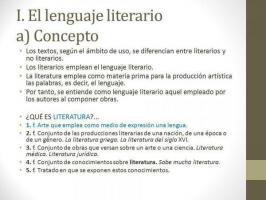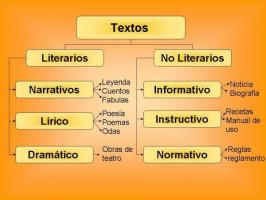What are GRAMMATICAL RESOURCES - SUMMARY + EXAMPLES !!
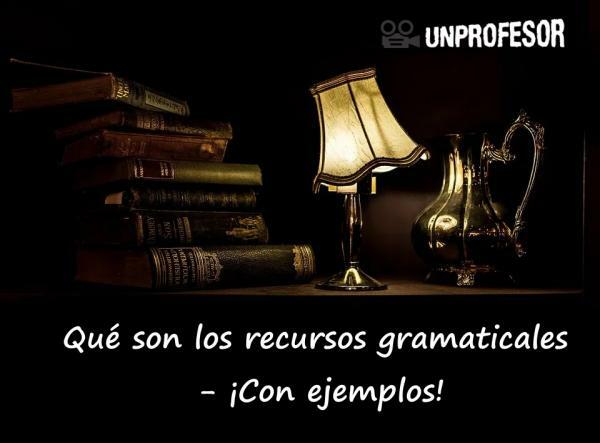
Literature looks for ways to adorn language to achieve that words convey beyond of its meaning. In this lesson from a PROFESSOR we want to talk to you about those expressions used in texts, whether they are in prose or verse, that are not used in common language as they make changes in the structure of the sentence or add and remove words simply by looking for the beauty. We want to show you what are grammar resources with examples.
When writing literature, it is common to find phrases or modes of expression that we do not use in conventional speech. That is, many authors rely on these resources to give more beauty to your writing making these more expressive. The only purpose of this type of resource is aesthetic since in most cases they focus in the modification of sentence structures, in the deletion, the addition of words or the repetition. Let's see what grammar resources exist and some examples of them.
Hyperbaton
Is a disturbance of the natural syntactic order of a sentence. It was a widely used resource in the 15th century in Latinizing prose and in the Baroque. Within it we can find different types:
- Thesis: sandwiches a word between two elements of another that is composed.
- Parenthesis: Enter a phrase or interjection with a different intonation.
- Anastrophe: the preposition is placed after the noun it accompanies.
- Hysterology: change the order of the words and state first what should come next.
Let's see an example of Solitudes from Garcilaso de la Vega:
Where sparkling the Sicilian sea
the silver silver foot to the Lilibeo
pale ashy signs a plain
of the hard job gives
Epithet
The epithet is a qualifying adjective or participle. Its function is to highlight some of the qualities of the noun that accompanies it. This quality is inherent to the name, that is, it does not provide any additional information that helps to define or describe the concept to which it is referring. Through the epithet the author seeks to mark more the descriptive meaning. So that you can see it clearly, here are some examples:
White snow covered the peaks.
The hot fire in the fireplace.
The cold ice of those lands.
The blue sea on the shores of your home.
Parallelism
This device is used mainly in rhetoric and is a stylistic device that consists of the repetition of syntactic structures that are the same or similar. On The Forbidden Pleasures, Luis Cernuda used it like this:
Beyond life
I want to tell you with death;
Beyond love,
I want to tell you with oblivion.
Anaphora
The anaphora is a conscious repetition of the same word or group of words at the beginning of different verses or statements when it is a prose text. It helps to give sound and rhythm to the text and is very efficient in oratory thanks to the fact that it is a rhetorical device. Miguel Hernández used this resource in his Elegy:
Death took flight early,
early the morning got up early,
early you're rolling on the floor
I do not forgive death in love,
I do not forgive inattentive life,
I do not forgive the earth or nothing.
Derivation
In order to make the text much more attractive, the author seeks the combination of different words that are drift from each other. That is to say, that all of them have the same lexeme or root. We can see it very clearly in the following example:
How do you want me to love you if the one I want him to love me doesn't love me the way I want him to?
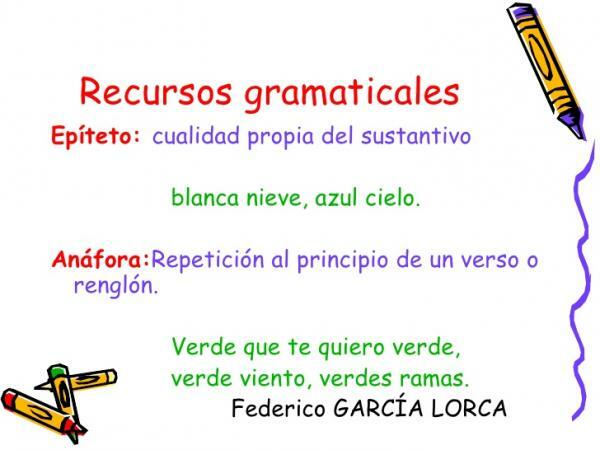
Image: Slideshare
In addition to the previous grammatical resources that are the most used, there are also others that, although less known, are also common in literary texts. They are as follows.
Epanadiplosis
Is based on the repetition of a word or group of words at the beginning and end of a verse so that the sentence begins and ends in the same way. This seeks a greater sound and beauty for the reader. In the Romance of the Duero written by Gerardo Diego, we can find an example of epanadiplosis:
Words of love, words.
Polysyndeton
This resource consciously repeats more conjunctions than you should, repeats the same in order to join different words, phrases or sentences. This is to pause the text, making it more reflective and slow. This song by Joaquín Sabina is a clear example of Polisíndeton:
And they gave us ten and eleven, twelve and one and two and three ...
Asyndeton
It is used when you want to give the text a faster expression, dynamic, agile and fluid. To do this, the elimination of conjunctions or links between different words is used to further intensify the message. This figure was used a lot during the Romanticism because of the passion it transmits, let's see an example in the poem Laziness by Gustavo Adolfo Bécquer:
Work, move, shake to eat!
Hit that bomb, sweat, strive to catch the air you have to breathe! [...]
How chaste, how mysterious, how full of sweet modesty is man's laziness always!
Anadiplosis and concatenation
It is a resource that consists of repetition of the same word at the end of one verse and beginning of the next. It can be a single word or a group of these. In this way, the author gives more agility to the poem so that it is easier to read. We can find an example in this poem by Miguel Hernández:
My temple, flowery balcony
of my early ages,
black is, and my heart,
and my heart with gray hair.
The concatenation, for its part, is also based on the same resource but is used only in prose.
Complexion
This resource appears when in the text the author has captured a succession of epiphoras and anaphora to highlight the beauty of it. It is a little-used resource, but here you can see an example by Rafael Alberti:
The sea. The sea.
The sea. Just the sea
Epiphora
Repeat one or more words at the end of several verses or phrases. Your goal is look for loudness even if it makes it difficult for the reader to understand. On the other hand, it seeks to surprise you because it is used very little in literature. This example by Luis Cernuda illustrates it very well:
He didn't say words
only approached a questioning body,
because I was unaware that desire is a question
whose answer does not exist,
a leaf whose branch does not exist,
a world whose sky does not exist.
You already know the grammar resources with examples, if you want to continue learning more about Literature, do not forget to visit our sections in which you will find more lessons like this and much more.
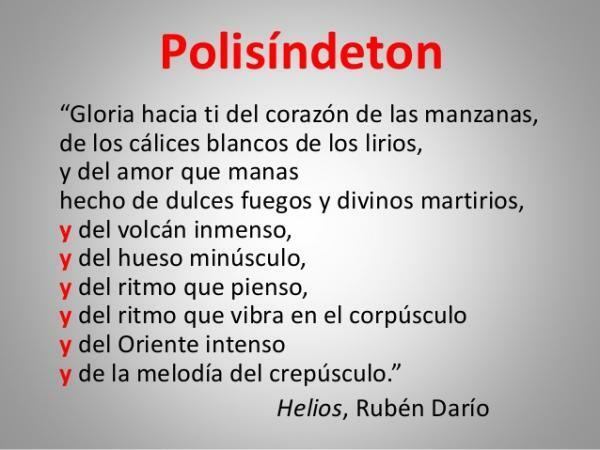
Image: Slideshare

